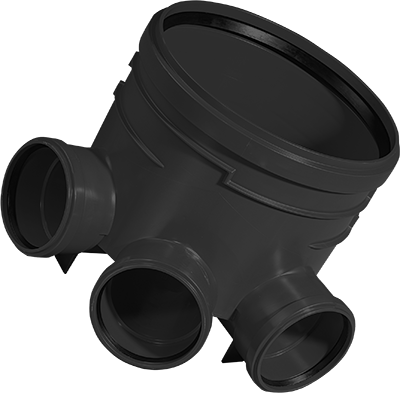

RESISTANCE TO SEVERE CONDITIONS
The RV-System OSMA is a modern, advanced system of well components designed for building inspection wells and yard inlets in difficult conditions. The RV has been designed and developed using the latest knowledge of plastics mechanics, as well as under the requirements of builders and operators of technical mains.
HIGH THERMAL AND CHEMICAL RESISTANCE, LOW RISK OF CLOGGING
In the realm of thermoplastic materials, polypropylene (PP) holds a most specific position thanks to its high thermal and chemical resistance and unrivalled toughness. This material processes very well, which makes an excellent choice for the production of well bottoms with absolute smoothness of the inner wall that resists abrasion, clogging, as well as outer soil pressure. Unplasticised polyvinylchloride (PVC-U) is regarded as the advanced and time-proven material. This is used in production of well pipes and telescopes that have their inner wall resistant to abrasion and a tough outer layer which is resistant to all typical materials used for pipe gritting and compaction.
HIGH DURABILITY, RESISTANCE TO WHEEL PRESSURE
Well bottoms introduce the benefit of a strengthened, ribbed wall that is resistant to ground pressure. The system of flexible joints between the well pipe and the telescopic extension, which may be fitted with various cast-iron lids, easily withstands wheel pressure of up to 400 kN.
EXCELLENT JOINT TIGHTNESS, LOW CLOGGING RISK
The tightness of system joints in both positive and negative pressure up to 0.5 bar is governed by a multi-blade sealing segment made from durable rubber. The element, which introduces cleaning, spacing, positioning and sealing blades, is fitted into a special chamber inside the neck. The entire system also provides excellent tightness even when the piping is deformed or misaligned.
EASY INSPECTION, WELL DEPTH UP TO 4 METRES
The RV-System OSMA® represents a full-scale system of individual elements that enable construction of wells with various depths. Furthermore, additional connection of new sewage branches is possible, as well as connection to various sewage systems.
100% RECYCLABILITY
Due to their low weight, the production, handling and assembly of the RV-System OSMA® plastic wells requires lower energy input, produces less carbon dioxide and the assembly is completed faster than when using concrete or cement systems. What is more, the entire system allows easy rework, which delivers compliance to stringent ecology criteria.




